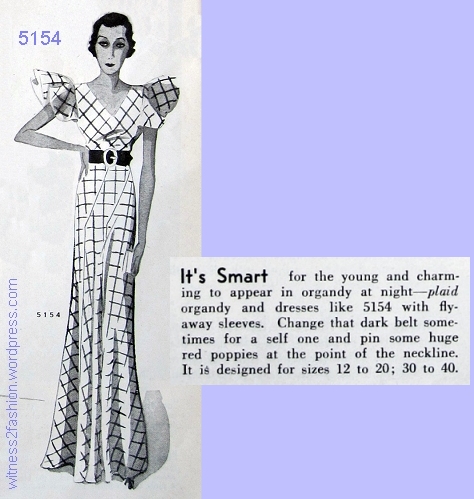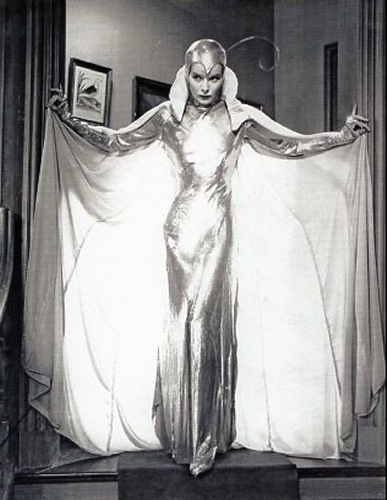The movie-linked patterns issued by Butterick in May of 1933 were designed by Howard Greer, for the movie Christopher Strong. Hepburn played an aviatrix in love with a married man, British MP Christopher Strong, and Helen Chandler played his daughter, Monica Strong.

Katharine Hepburn and Helen Chandler wearing Howard’s Greer’s designs, copied as Butterick Starred Patterns. Delineator, May 1933.
This was only Katharine Hepburn’s second movie.
After a New York stage success, “… she was cast in A Bill of Divorcement (1932), opposite John Barrymore. The film was a hit, and after agreeing to her salary demands, RKO signed her to a contract. She made five films between 1932 and 1934. For her third, Morning Glory (1933) she won her first Academy Award. Her fourth, Little Women (1933) was the most successful picture of its day.” — Internet Movie Database (IMDb.)
Helen Chandler, a successful stage actress, is probably best remembered in films as a victim of Bela Lugosi’s Dracula (1931), although she appeared in over two dozen movies. Her later life was a sad one.
Here is Delineator raving about young Katharine Hepburn:
“Delineator is especially interested in Katharine Hepburn because of the way she wears clothes. She has that thing called chic…. What she wears in a picture to-day has a good chance of being what Young America is going to demand tomorrow.” By 1933, fashion magazines like Delineator were beginning to appreciate that movie costumes might have more influence on young women’s clothing choices than Paris fashions. (The “Letty Lynton dress”of 1932 had created a great demand for copies.) Butterick entered into agreements with three studios — Warner Bros., R.K.O., and Paramount — which allowed Butterick to make exact copies of dresses worn in their movies. This was quite different from the Hollywood Pattern Company’s approach. However, for whatever reason, only a few of these Butterick Starred Patterns were ever issued.
This one, designed for Katharine Hepburn by Howard Greer, was Butterick 5156. It included a pattern for the tucked hat. The open sleeves were seen on other dresses in the 1930’s. You can see the pattern envelope, with alternate views, by clicking here.
Helen Chandler’s gown, No. 5154, was made of organdy — like the Letty Lynton dress — and trimmed with lace.

Butterick Starred Pattern 5154 was designed for Helen Chandler by Howard Greer. Delineator, May 1933.
The “lace is sewed along one edge only;” i.e., it is not labor-intensive insertion lace. A variation of this evening pattern, made in plaid organdy, was illustrated two months later, in the July issue of Delineator. There was no mention of its movie connection.

Butterick pattern 5154 as illustrated and described in Delineator, July 1933. “Pin some huge red poppies at the point of the neckline.”
You can see the Starred Pattern envelope for Butterick 5154 at the Commercial Pattern Archive; Click here.
Howard Greer, Costume Designer
Designer Howard Greer had been working in the movies since the 1920’s. Jay Jorgenson and Donald L. Scoggins, authors of Creating the Illusion, put their chapter about him in the Silent Era. For a while, he was head of the wardrobe department at Paramount Studios, but he said he did his best work in three dimensions, while his friend and associateTravis Banton had a genius for what would look good on the screen. In 1927, Greer left Paramount to start his own custom clothing salon in Los Angeles. Many of his clients were movie stars. He obviously moved back and forth between his work for private clients and his film costume design, usually only designing gowns for the star. One of his later films was Bringing Up Baby, also with Katharine Hepburn. In the 1940’s, he started a ready-to-wear business. His last film credit was lingerie for Joan Crawford in Sudden Fear (1952). He was also a mentor to Edith Head, giving her her first job at Paramount Studios.
Greer’s most famous costume from Christopher Strong was Katharine Hepburn’s metallic lame “moth” outfit; in this scene, she’s on her way to a masquerade ball:

Katharine Hepburn in Christopher Strong, wearing a Moth Costume by Howard Greer. From Creating the Illusion.
TCM has a great 2 minute video that shows her making an entrance in it — Wait for it! “Forgive me if I keep staring at you,” says Colin Clive. No kidding.
This is Part Four of a Series about Butterick Starred Patterns. Part 1, Part 2, and Part 3 were patterns based on designs by Orry-Kelly, for Warner Brothers movies.
Next: Butterick Starred Costumes Part 5: Helen Twelvetrees and Designer Travis Banton






Very interesting. I especially like the moth outfit.
Pingback: Butterick Starred Patterns Part 5: Helen Twelvetrees Wears Travis Banton | witness2fashion
Pingback: Bare Shoulders, December 1933 | witness2fashion
Pingback: Fashion Advice for Summer, 1933 (Part 2) | witness2fashion
Pingback: Serendipity: 1933 Wedding Gown & Its Rare Pattern | witness2fashion